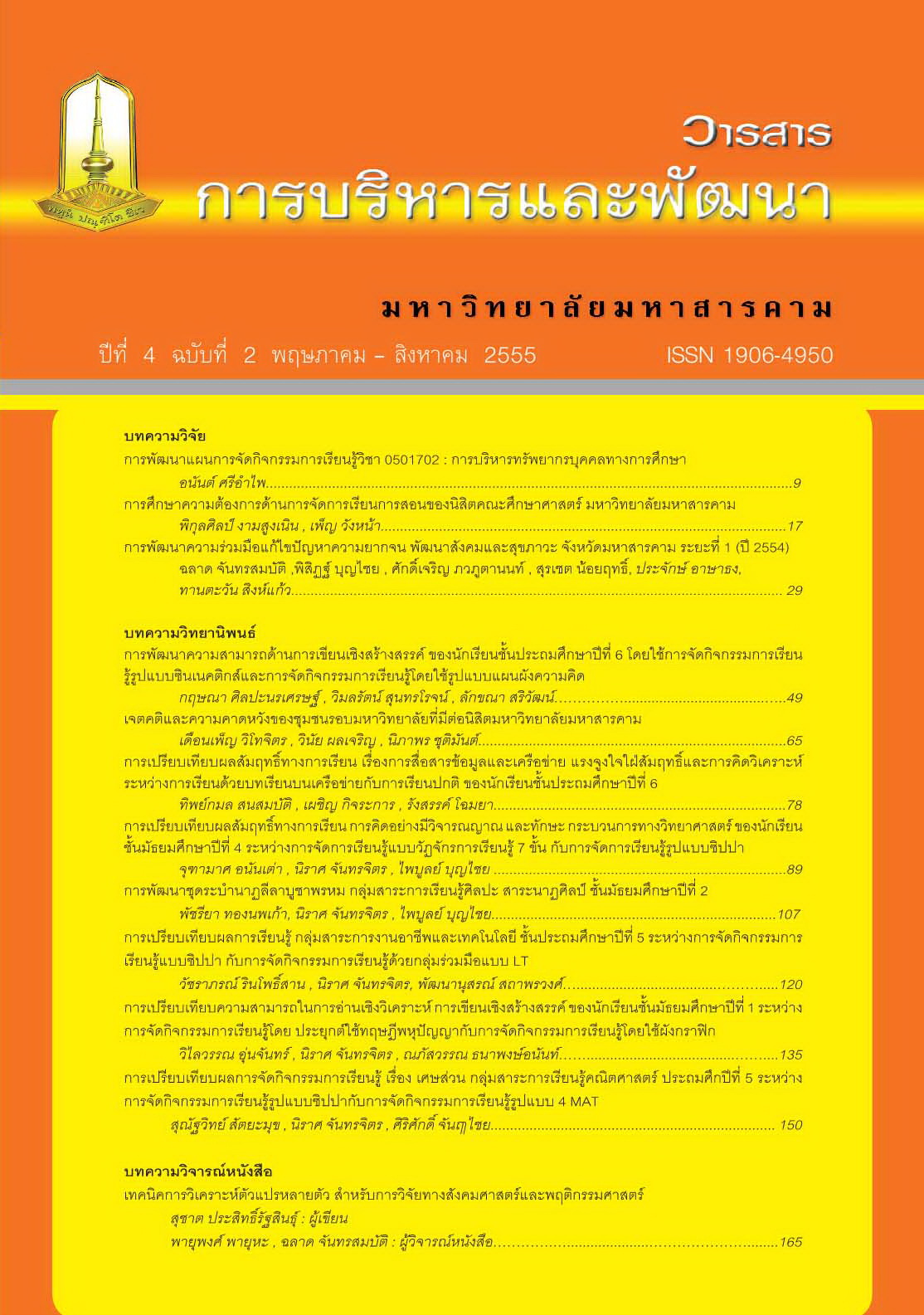การเปรียบเทียบผลสัมฤทธิ์ทางการเรียน การคิดอย่างมีวิจารณญาณ และทักษะกระบวนการทางวิทยาศาสตร์ของนักเรียนชั้นมัธยมศึกษาปีที่ 4 ระหว่างการจัดการเรียนรู้แบบวัฏจักรการเรียนรู้ 7 ขั้นกับการจัดการเรียนรู้รูปแบบซิปปา
Main Article Content
Abstract
บทคัดย่อ
การวิจัยครั้งนี้มีความมุ่งหมายเพื่อ 1) พัฒนาแผนการจัดการเรียนรู้แบบชุ้จักรการเรียนรู้ 7 ขั้น และแผนการจัดการเรียนรู้รูปแบบซิปปา เรื่อง แรง มวล และกฎการเคลื่อนที่ ชั้นมัธยมศึกษาปีที่ 4 ที่มีประสิทธิภาพตามเกณฑ์ 75/75 2) หาดัชนีประสิทธิผลของแผนการจัดการเรียนรู้แบบ วัฏจักรการเรียนรู้ 7 ขั้น และแผนการจัดการเรียนรู้รูปแบบซิปปา ชั้นมัธยมศึกษาปีที่ 4 3) เปรียบเทียบผลสัมฤทธิ์ทางการเรียนการคิดอย่างมีวิจารณญาณและทักษะกระบวนการทางวิทยาศาสตร์ของนักเรียนชั้นมัธยมศึกษาปีที่ 4 หลังเรียนระหว่างกลุ่มที่จัดการเรียนรู้สองรูปแบบ กลุ่มตัวอย่างที่ใช้ในการวิจัยครั้งนี้ได้แก่ นักเรียนชั้นมัธยมศึกษาปีที่ 4/5 และชั้นมัธยมศึกษาปีที่ 4/6 โรงเรียน แท้งคร้อวิทยา อำเภอแท้งคร้อ จังหวัดชัยภูมิภาคเรียนที่ 1 ปีการศึกษา 2552จำนวนห้องละ40 คน รวมจำนวน 80คนซึ่งได้มาโดยการสุ่มแบบกลุ่ม (Cluster Random Sampling) และจับสลากห้องเรียนชั้นมัธยมศึกษาปีที่ 4/6 เป็นกลุ่มจัดการเรียนรู้แบบวัฏจักรการเรียนรู้ 7 ขั้น และห้องเรียนชั้นมัธยมศึกษาปีที่ 4/5 เป็นกลุ่มจัดการเรียนรู้รูปแบบซิปปา เครื่องมือที่ใช้เก็บรวบรวมข้อมูล ได้แก่ แผนการจัดการเรียนรู้แบบวัฎจักรการเรียนรู้ 7 ขั้น และแผนการจัดการเรียนรู้รูปแบบซิปปา รูปแบบละ 9 แผน รวมเวลาเรียนรูปแบบละ 18 ชั่วโมง แบบทดสอบวัดผลสัมฤทธิ์ทางการเรียนชนิดเลือกตอบแบบปรนัย 4 ตัวเลือก จำนวน 40 ข้อ แบบทดสอบวัดการคิดอย่างมีวิจารณญาณ ชนิดเลือกตอบ จำนวน 30 ข้อ และแบบทดสอบวัดทักษะกระบวนการทางวิทยาศาสตร์จำนวน 30 ข้อ สถิติที่ใช้วิเคราะห์ข้อมูล ได้แก่ ค่าเฉลี่ย ส่วนเบี่ยงเบนมาตรฐาน และทดสอบสมมติฐาน โดยใช้ t-test (Independent Sample) และ Hotelling’s Trace
ผลการวิจัยปรากฏดังนี้
1. แผนการจัดการเรียนร้แบบวัฏจักรการเรียนรู้ 7 ขั้น และการจัดการเรียนรู้รูปแบบซิปปา เรอง แรง มวล และกฎการเคลื่อนที่ ชั้นมัธยมศึกษาปีที่ 4 มีประสิทธิภาพ เท่ากับ 80.51/78.88 และ 75.15/76.56 ตามลำดับ
2. ดัชนีประสิทธิผลของแผนการจัดการเรียนรู้แบบวัฏจักรการเรียนรู้ 7 ขั้น และการจัดการเรียนรู้รูปแบบซิปปาที่วิเคราะห์จากคะแนนผลสัมฤทธิ์ทางการเรียน การคิดอย่างมีวิจารณญาณ และทักษะกระบวนการทางวิทยาศาสตร์ มีค่าเท่ากับ 0.6265, 0.4718, 0.3878 และมีค่าเท่ากับ 0.5578, 0.3966, 0.3640 ตามลำดับ
3. นักเรียนที่เรียนด้วยการจัดการเรียนรู้แบบวัฏจักรการเรียนรู้ 7 ขั้น และการจัดการเรียนรู้รูปแบบซิปปา มีผลสัมฤทธิ์ทางการเรียนและทักษะกระบวนการทางวิทยาศาสตร์หลังเรียนไม่แตกต่างกัน แต่กลุ่มที่จัดการเรียนรู้แบบวัฏจักรการเรียนรู้ 7 ขั้น มีการคิดอย่างมีวิจารณญาณสูงกว่า นักเรียนที่เรียนด้วยการจัดการเรียนรู้รูปแบบซิปปาอย่างมีนัยสำคัญทางสถิติที่ระดับ .05
คำสำคัญ : การจัดการเรียนรู้แบบวัฏจักรการเรียนรู้ 7 ขั้น, การจัดการเรียนรู้รูปแบบซิปปา, ผลสัมฤทธิ์ทางการเรียน, ทักษะกระบวนการทางวิทยาศาสตร์, การคิดอย่างมีวิจารณญาณ
ABSTRACT
The purposes of this study were: 1) to develop the learning organizations of the 7Es inquiry learning approach and CIPPA learning model with a required efficiency of 75/75, 2) to find out effectiveness indices of those two types of learning activities, 3) to compare effects of learning achievement, critical thinking, and scientific process skills of two groups mathayomsuksa 4 students between using the 7Es inquiry learning approach and CIPPA learning model. The samples used in this study consisted of 80 Mathayomsuksa 4 students attending Kang-Krawwithaya School, Kang-Kraw District, Chaiyapoom Province in the first semester of the academic year 2009. They were assigned to organize by the 7Es inquiry learning approach and CIPPA learning model for the students’ group 4/6 and 4/5 respectively, with 40 students in each group, obtained using the cluster random sampling technique. The instruments used for gathering data were plans for science learning entitled Force, Mass and Law of Mobilization, 9 plans each, for 18 hours of learning; a 40-item achievement test, a 30-item critical thinking test, and 30 item scientific process skills test. The statistics used for analyzing the gathered data were a mean, a percentage, a standard deviation; and the statistics used for testing hypotheses were the t-test (Independent Samples) and Hotelling’s T2.
The results of the study were as follows :
1. The organization of learning activities using the 7Es inquiry learning approach and CIPPA learning model approachs for Mathayomsuksa 4 had efficiencies of 80.51/78.88 , and of 75.15/76.56 respectively.
2. The effectiveness indices of learning organization of the 7Es inquiry learning approach and CIPPA learning model approach, which analyzed from learning achievement, critical thinking, and scientific process skills scores were 0.6265, 0.4718, 0.3878 and 0.5578, 0.3966, 0.3640 respectively.
3. The students who learned using the 7Es inquiry learning approach and using CIPPA learning model had not difference of learning achievement and scientific process skills, but the group of using the 7Es inquiry learning approach had critical thinking skills higher than group of using CIPPA learning model at the .05 level of significance.
Keywords: 7Es inquiry learning approach, CIPPA learning model, Learning achievement, Scientific process skills, Critical thinking skills

